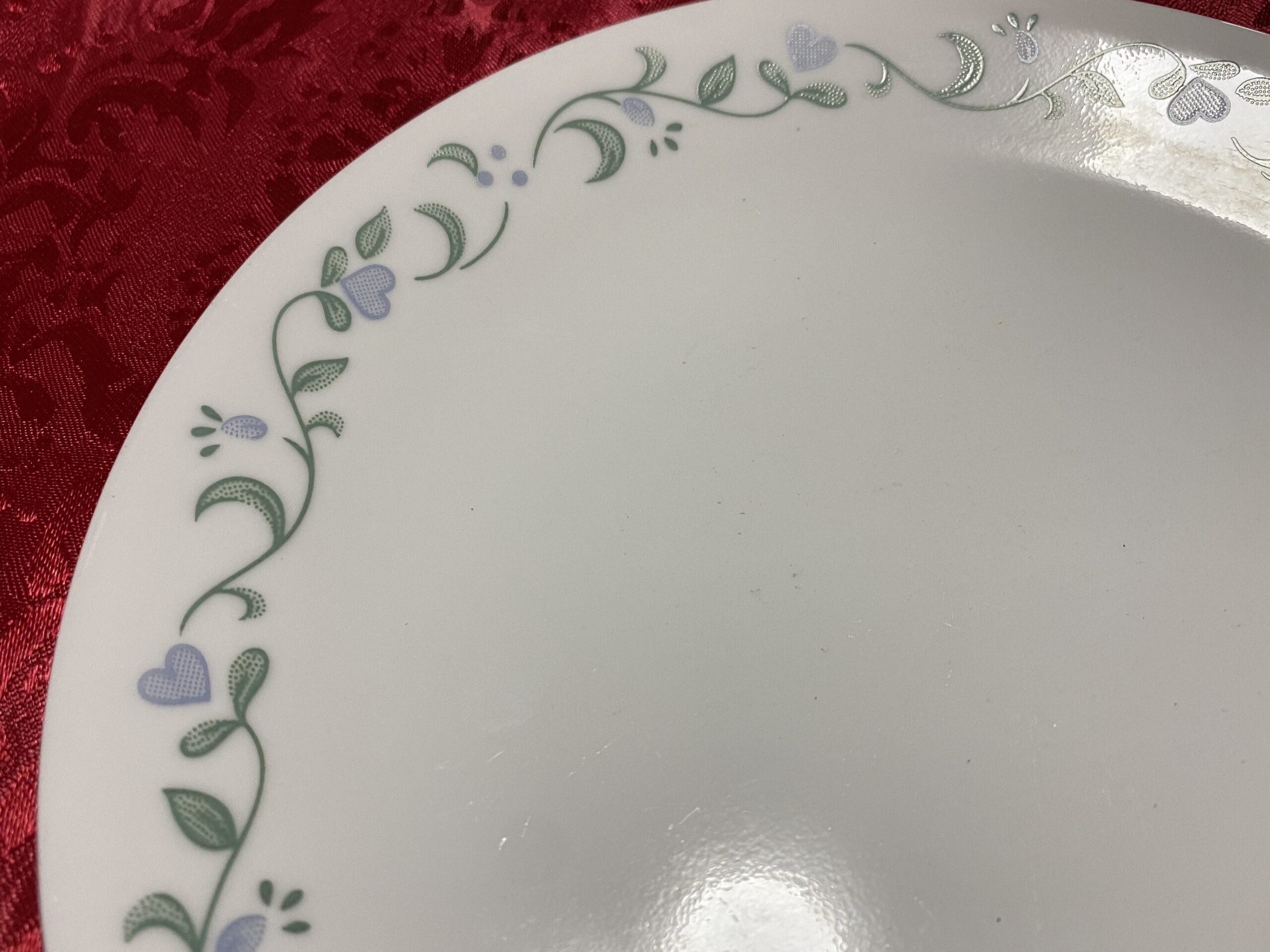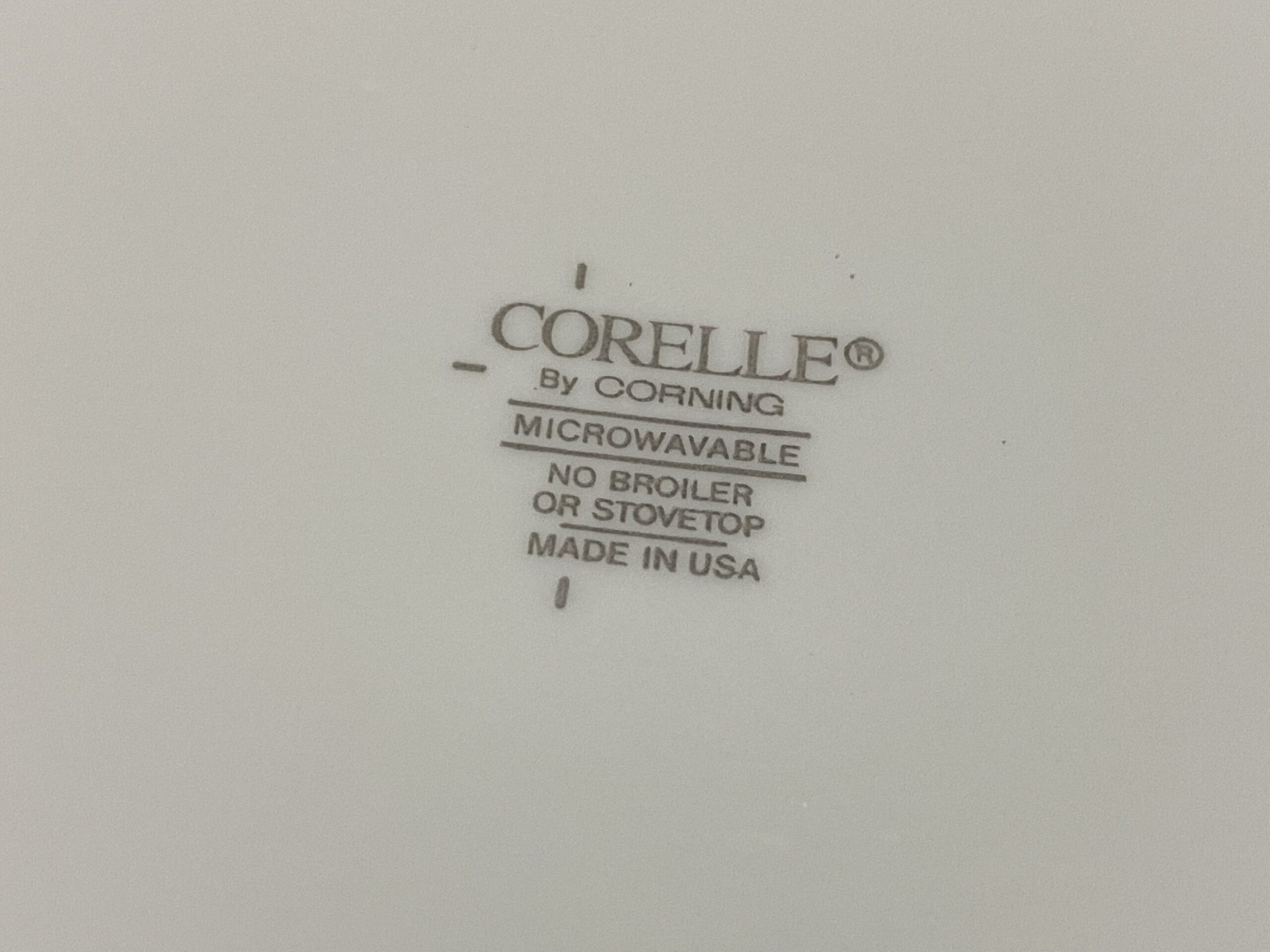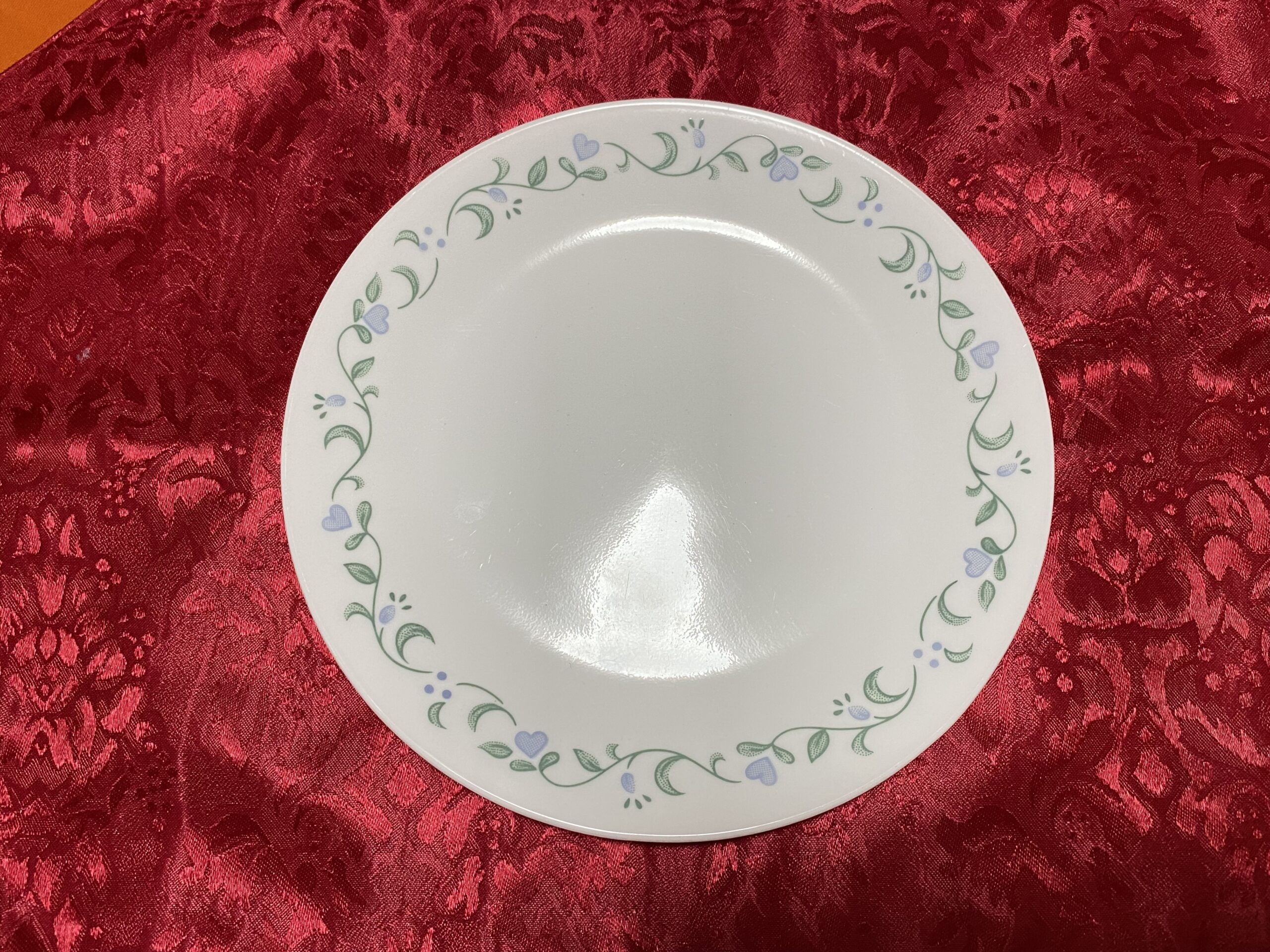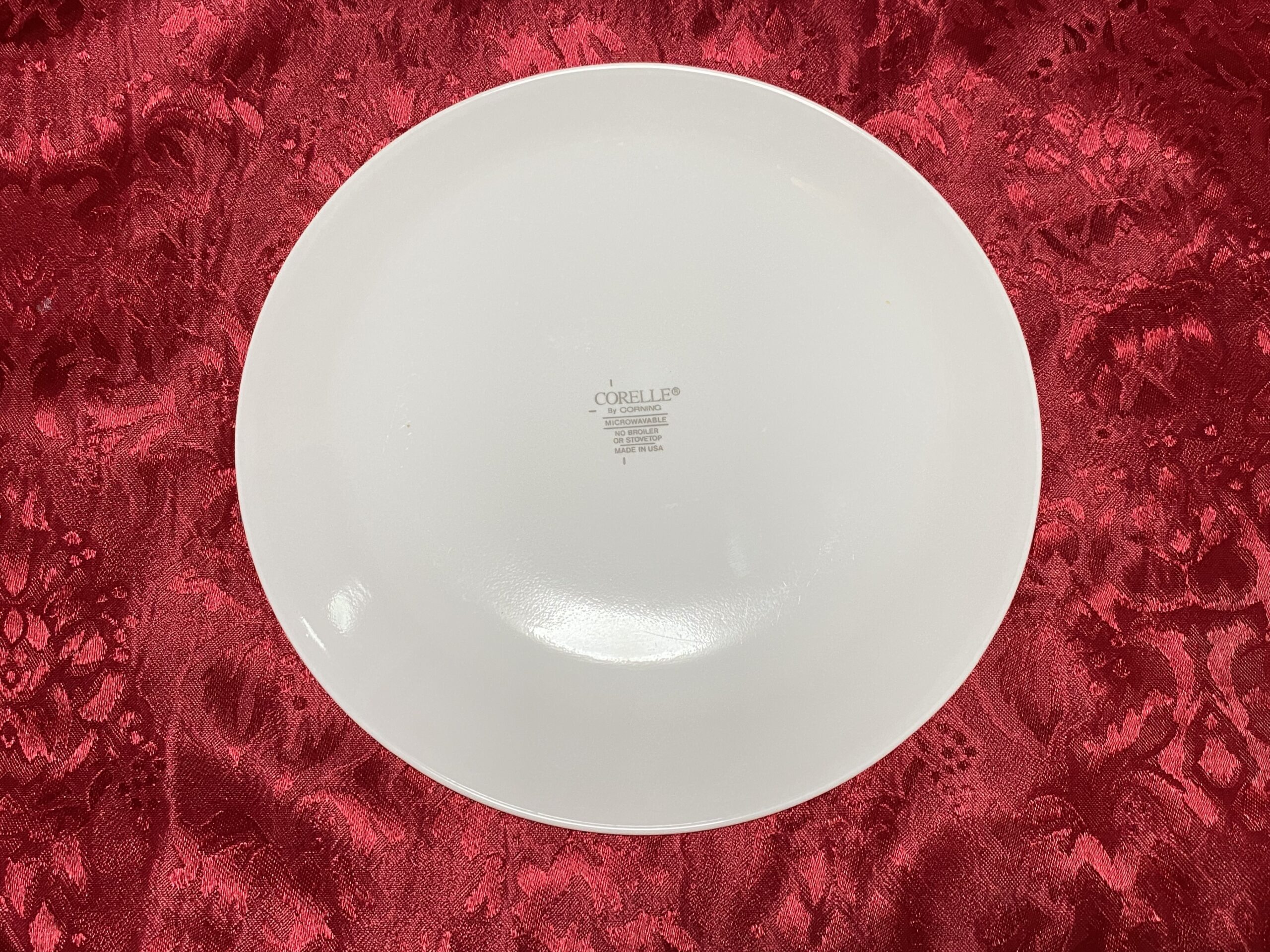Modern (post 2005?) Corelle dish with blue heart-shaped flowers, green leaves and vines: Positive for trace levels of Lead and Cadmium (safe by all standards)
For those new to this website:
Tamara Rubin is a multiple-federal-award-winning independent advocate for childhood Lead poisoning prevention and consumer goods safety, and a documentary filmmaker. She is also a mother of Lead-poisoned children (two of her sons were acutely Lead-poisoned in 2005). Since 2009, Tamara has been using XRF technology (a scientific method used by the U.S. Consumer Product Safety Commission) to test consumer goods for toxicants (specifically heavy metals — including Lead, Cadmium, Mercury, Antimony, and Arsenic). Tamara’s work was featured in Consumer Reports Magazine in February of 2023 (March 2023 print edition).
Below, you will find the XRF readings for metals found in the item pictured. All readings are done multiple times to confirm the results for each component before sharing one full set of readings for the item pictured. Results are replicable, science-based, and accurate.
For some additional background about this work, please read the following links:
- This article discusses the testing methodology used here on this website.
- This is a menu with buttons for many of the different information categories available here on LeadSafeMama.com.
- Here’s a link to my documentary feature film on childhood Lead poisoning.
- And, a link to a short video walking you through how to search this site.
- Here are some items you can test at home with a LeadCheck swab.
- And, some items you really cannot test at home (are better tested with XRF technology).
- This is an article discussing some contexts for the concern of Lead in ceramics/ dishware/ pottery.
- This article discusses why you cannot (in most cases) test dishware yourself at home.
Reading #1.) Blue hearts on the Corelle dish food surface
30-second reading
- Lead (Pb): 12 +/- 5 ppm
- Cadmium (Cd): non-detect
- Mercury (Hg): non-detect
- Bromine (Br): non-detect
- Chromium (Cr): 484 +/- 196 ppm
- Vanadium (V): 2,884 +/- 478 ppm
- Iron (Fe): 366 +/- 68 ppm
- Cobalt (Co): 823 +/- 57 ppm
- Copper (Cu): 28 +/- 16 ppm
- Zinc (Zn): 1,858 +/- 52 ppm
- Barium (Ba): 97 +/- 20 ppm
- Bismuth (Bi): 21+/- 6 ppm
- No other metals were detected in consumer goods mode.
Reading #2.) Center of Corelle dish white food surface
30-second reading
- Lead (Pb): non-detect
- Cadmium (Cd): 54 +/- 12 ppm
- Mercury (Hg): non-detect
- Bromine (Br): non-detect
- Chromium (Cr): 1,761 +/- 148 ppm
- Vanadium (V): 2,622 +/- 330 ppm
- Iron (Fe): 299 +/- 52 ppm
- Cobalt (Co): 63 +/- 22 ppm
- Zinc (Zn): 1,321 +/- 38 ppm
- Titanium (Ti): 9,375 +/- 453 ppm
- Barium (Ba): 3,871 +/- 158 ppm
- Bismuth (Bi): 57+/- 10 ppm
- No other metals were detected in consumer goods mode.
Reading #3.) Green leaf on Corelle dish
30-second reading
- Lead (Pb): non-detect
- Cadmium (Cd): non-detect
- Mercury (Hg): non-detect
- Bromine (Br): non-detect
- Chromium (Cr): non-detect
- Iron (Fe): 286 +/- 68 ppm
- Zinc (Zn): 13 +/- 8 ppm
- Zirconium (Zr): 3,461 +/- 58 ppm
- Tin (Sn): 10 +/- 5 ppm
- No other metals were detected in consumer goods mode.
Reading #4.) Back logo on Corelle dish
30-second reading
- Lead (Pb): non-detect
- Cadmium (Cd): 5 +/- 3 ppm
- Mercury (Hg): non-detect
- Bromine (Br): non-detect
- Iron (Fe): 615 +/- 78 ppm
- Cobalt (Co): 233 +/- 41 ppm
- Zinc (Zn): 384 +/- 22 ppm
- Titanium (Ti): 6,488 +/- 860 ppm
- Zirconium (Zr): 1,379 +/- 26 ppm
- No other metals were detected in consumer goods mode.
Some additional reading that may be of interest:
- Here are some additional Corelle pieces we have tested.
- Here’s my overview article with other types of china we have tested.
- Here’s the “Made In USA” category of the site.
As always, please let me know if you have any questions. Thank you for reading and thank you for sharing this work.
Tamara Rubin
#LeadSafeMama

Never Miss an Important Article Again!
Join our Email List













What does safe by all standards mean? As In you consider it to be safe to use?
Hi, I have this design. I am uncertain if this is safe to use. If it is not safe to use, will Correlle take it back?
Thank you
I believe this design is called Country Cottage.
Thank you for commenting!
T
What does safe by all standards mean?
It means exactly that. It meets or exceeds the considerations for all standards INCLUDING the standards for items intended for use by children (which most dishes do not.)
T
I have the blue heart dishes . What is considered safe?
Under 90 ppm is considered safe.
So is this one safe to use or no?
Wondering if this is still safe to use? Should I be looking for a new set and how will I know it another brand of dishware is safe or not. I’ve had this for many many years.
Yes Country Cottage Iis what I still have and use regularly. Looks like I need to get rid of it. So sad about this. I really like my Corelle.
I still have these and use them everyday I will be looking for something different. Have you ever tested the English breakfast corelles with the pink and blue ribbons and little flowers?
Hi Missy!
Thank you for commenting. I will look and see what I have in my archives and get back to you a.s.a.p.
Tamara
I also would be interested to know the levels for English Breakfast as my parents are still using these, and I ate off of them all through my childhood/young adulthood.
Yes I also have English breakfast
I have a huge set of the Country Cottage Corelle ware. Are these reading to high to continue using my dishes!
Same question. Are the levels to high to continue to use these dishes?
Is the country cottage safe ?
I’m still confused about the country cottage design. Is the trace levels safe according to you? Or is your position that the recognized safe levels are in actuality unsafe?
What lead level is unacceptable? How do you know what year dishes were made?
Hi there. You only mention the 2005+ sets. I have the same set from about 1997. Does that mean it has lead or is safe
Pre-2005 generally has unsafe levels of Lead.
Tamara
I am so confused. Are you saying this design is safe to use or not
Is Corelle safe to buy in 2022? I have the country cottage set that I must get rid of and I would like to buy Corelle again.
Is the cadmium level on the center white surface dangerous? Have been using these since well before 2005!
I have Xmas holly pattern use the mugs daily gift in the 1980s
Like these?: https://tamararubin.com/2018/09/vintage-christmas-made-in-usa-corning-glass-mug-holly-berry-pattern-28200-ppm-lead/
These are a definite exposure risk. Please read the article linked in this post:
https://tamararubin.com/2017/11/decorated-glassware/
T
I’ve had this pattern since the mid 90’s, it is called Country Cottage.
Thank you for the research.
I have this set. Is there any way to tell if it is post 2005 or pre 2005?
I had this set in 2000, so it is pre-2005.
I have this set and some of the all white plates.
After reading this and all the responses and question asked I still don’t know if my Country Cottage dishes are safe to use. I’ve been using them since 2000-2001. Does that mean I have already been exposed to levels of lead that are unhealthy?
I also have the casserole dishes in the same pattern. Should I replace these as well?
i believe that means theyre likely unsafe. you might just want to grab a different more recent set to be safe.
How can we tell what year our Country Cottage dishes were made? Are those purchased after 2005 safe?
Based on the findings, are these plates considered safe to use or is it recommended that we stop using them. I’ve seen this question asked above but haven’t seen a clear answer posted.
Do you know the lead level on the Callaway pattern?
This set with the blue hearts and green leaves and vines, my wife informed me she got as a gift at her wedding shower in 1995. So they are definitely dated pre-1995.
We have been using them ever since.
I assume by your testing this set is in the acceptable standard range?
So is Country Cottage safe or not. Please answer everyone.
The Country Cottage pattern that many of us are questioning was made both BEFORE AND AFTER 2005. I cannot find any answers as to how to determine when mine were produced. Very, very frustrating.
I have the callaway patern !! Is it safe??
Could you please send pictures of the dishes that are dangerous to eat on that would make it so much easier than trying to read and figure out what is and what is it
I have this set which I received as a wedding gift in 1999 so it must be an exception to the rule as they were no longer making this pattern after about 2001 or so (at least to my knowledge as I tried to find it in stores to add to my collection and never found any- assume it was discontinued). I’m guessing these weren’t re-released after 2005 since they were no longer in style. If these were the ones tested then they must be safe.
We got ours new from the store in 2004.
Should test similarly if colors are similar.
t
Just wow Tamara! As I read the results as an analytical chemist, functional nutritionist, degrees in Environmental Studies and Biochemistry and owner of 2 sets of this design of Corelle dishes (purchased ~2013/14) – and comparing them to the EPA Cd standards for water (where it’s all in there and not mostly on the plate)
— These are pretty good, but most people aren’t me and you’ve got a lot of people who’ve commented freaking out about if they need to get rid of their dishes – begging you for followup and assurance and you are not responding to all of them. You really should. It feels sort of irresponsible and mean to drop numbers they don’t understand without more explanation – especially as this page of results is turning up all over FaceBook.
Hello Annelise, Thanks for commenting.
The details discussing the implications of the results are linked on most of the pages of the website and specifically are all linked on the overview article. People like their information compartmentalized and aren’t about to read a 10 page article unfortunately. I approve comments sometimes with my disabled (lead poisoned) kids underfoot – and my long-term readers do a good job of answering questions when I cannot. Unfortunately I cannot account for every person who doesn’t take the time to read the links with more information answering their questions – but I do try.
When something is noted as being “Safe By All Standards” (as this one is) – that means exactly that. The item is safe by all standards. The START HERE post (on the home page) is a good place to get follow up questions answered and the video (in the side bar of every page of the website) also shows how to find information that answers pretty much every question. There are also lots of good links with background information in the MENU of the website – which is on the header of every page.
Here are some links:
Start here:
https://tamararubin.com/2022/05/start-here/
How to use the video:
https://tamararubin.com/2020/12/how-to-use-the-lead-safe-mama-website-video/
Background post on toxicants in dishware:
https://tamararubin.com/topics/does-vintage-and-new-functional-pottery-and-dishware-have-unsafe-levels-of-lead/
Unfortunately as a mother of disabled children, while I do try to answer every question in the comments on the website – with over 1,000,000 visitors this month it is physically not possible.
Tamara
Thank you. This is an excellent response. I hope the people posting above who were panicking find it.
The main response is actually in the title of the article… “safe by all standards” 🙂
I routinely test my blood around every 6 months for heavy metals at the same time I check Vitamin D levels. I live as chemically free as possible, using non toxic cleaning supplies in my home and eating only organic food. We don’t use chemical pesticides or herbicides. I don’t have new furniture or clothing. I’ve been cooking exclusively with Pyrex and Corning white pyroceram for several years. I used Frost White Corelle dishes for many years but purchased this Country Cottage pattern at Walmart within the last 18 months or so believing the new patterns were lead free. It’s a new set. My most recent blood test shows my lead levels have gone up. It has gone from .87 ug/dL to 1.46 ug/dL. I cannot figure out anything else that could be causing this. I do heat food on these plates in the oven and I’m wondering if that could be part of the problem. I guess I’m going back to only the plain white Corelle dishes.
Corelle specifically says on the bottom of their dish ware that it is not safe for oven use. Not sure if this is really the issue as many of us microwave (more worrisome in my opinion). Suspect breakage is the risk in oven. Note: testing indicated cottage garden was deemed safe BUT does not indicate the specific year tested. My recommendation is to call Corelle directly to confirm before discarding.
The year that we tested the product is at the top of the article. Unfortunately the year of manufacture is not noted on any of their dishes.
Tamara
Just for clarification, is the “country cottage” plate you tested pre-2005? I bought some plates of this design in 2019 but I also bought plates of this design at a second hand store and I would imagine they’re from a previous year. I have no way of knowing which plates I bought new and which ones I did not. Is the plate your tested as “safe by all standards” reflecting the older plates too?
Thanks for all the work you do!
The fact that “Tamara” can reply several times with a “thanks for replying” message, yet not just answer someone with a simple “yes/no country cottage is safe” says a lot to me.
Hi “Matt”, did you read the headline for the article?
I am a mother of disabled children who were acutely lead poisoned as babies. I do my best to answer as many questions as I can and I have helpers (volunteers and others) answering too. When the question is answered in the headline (and also answered multiple times in the comments thread)… well sometimes a personal answer doesn’t happen right away.
This dish (year of manufacture unknown) is “Safe by All Standards”
As a mother of acutely lead poisoned children I would never permit any dishes with any amount of Lead in my kitchen or for use anywhere in my home, however this is safe by all government standards. It’s up to you to choose if you are comfortable with the current government standards. It’s up to you to do that research and decide if – based on science – you feel the government standards are strict enough to protect your family… if the government standards are safe by YOUR standards.
Did you wake up on the wrong side of the bed Matt? Or are you always this cynical and grumpy? [Maybe you were still bleary eyed from sleep and didn’t bother to read the headline first?]
T
We bought these dishes in 1997-1998, they are not post-2005! They were new as of 1997 as far as I’m aware.
Doe Blue Fleur contain lead? Have been using it since 1994.